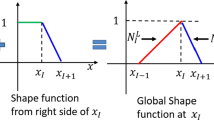Abstract
The convergence rate of classic domain decomposition methods in general deteriorates severely for large discontinuities in the coefficient functions of the considered partial differential equation. To retain the robustness for such highly heterogeneous problems, the coarse space can be enriched by additional coarse basis functions. These can be obtained by solving local generalized eigenvalue problems on subdomain edges. In order to reduce the number of eigenvalue problems and thus the computational cost, we use a neural network to predict the geometric location of critical edges, i.e., edges where the eigenvalue problem is indispensable. As input data for the neural network, we use function evaluations of the coefficient function within the two subdomains adjacent to an edge. In the present article, we examine the effect of computing the input data only in a neighborhood of the edge, i.e., on slabs next to the edge. We show numerical results for both the training data as well as for a concrete test problem in form of a microsection subsection for linear elasticity problems. We observe that computing the sampling points only in one half or one quarter of each subdomain still provides robust algorithms.
Access this chapter
Tax calculation will be finalised at checkout
Purchases are for personal use only
Similar content being viewed by others
References
I. Goodfellow, Y. Bengio, and A. Courville. Deep learning, volume 1. MIT press Cambridge, 2016.
A. Heinlein, A. Klawonn, J. Knepper, and O. Rheinbach. An adaptive GDSW coarse space for two-level overlapping Schwarz methods in two dimensions. 2019. Proceedings of the International Conference on Domain Decomposition Methods 24, Springer LNCSE, Vol. 125, January 2019, pp. 373–382. https://doi.org/10.1007/978-3-319-93873-8_35.
A. Heinlein, A. Klawonn, J. Knepper, and O. Rheinbach. Multiscale coarse spaces for overlapping Schwarz methods based on the ACMS space in 2D. Electronic Transactions on Numerical Analysis (ETNA), 48:156–182, 2018.
A. Heinlein, A. Klawonn, M. Lanser, and J. Weber. Machine Learning in Adaptive FETI-DP - A Comparison of Smart and Random Training Data. 2018. TR series, Center for Data and Simulation Science, University of Cologne, Germany, Vol. 2018-5. http://kups.ub.uni-koeln.de/id/eprint/8645. Accepted for publication in the proceedings of the International Conference on Domain Decomposition Methods 25, Springer LNCSE, May 2019.
A. Heinlein, A. Klawonn, M. Lanser, and J. Weber. Machine Learning in Adaptive Domain Decomposition Methods - Predicting the Geometric Location of Constraints. SIAM J. Sci. Comput., 41(6):A3887–A3912, 2019.
M. Jarošová, A. Klawonn, and O. Rheinbach. Projector preconditioning and transformation of basis in FETI-DP algorithms for contact problems. Math. Comput. Simulation, 82(10):1894–1907, 2012.
A. Klawonn, M. Kühn, and O. Rheinbach. Adaptive coarse spaces for FETI-DP in three dimensions. SIAM J. Sci. Comput., 38(5):A2880–A2911, 2016.
A. Klawonn, M. Kühn, and O. Rheinbach. Adaptive FETI-DP and BDDC methods with a generalized transformation of basis for heterogeneous problems. Electron. Trans. Numer. Anal., 49:1–27, 2018.
A. Klawonn and O. Rheinbach. Deflation, projector preconditioning, and balancing in iterative substructuring methods: connections and new results. SIAM J. Sci. Comput., 34(1):A459–A484, 2012.
A. Klawonn and O. B. Widlund. Dual-primal FETI methods for linear elasticity. Comm. Pure Appl. Math., 59(11):1523–1572, 2006.
J. Mandel and B. Sousedík. Adaptive selection of face coarse degrees of freedom in the BDDC and the FETI-DP iterative substructuring methods. Comput. Methods Appl. Mech. Engrg., 196(8):1389–1399, 2007.
J. Mandel, B. Sousedík, and J. Sístek. Adaptive BDDC in three dimensions. Math. Comput. Simulation, 82(10):1812–1831, 2012.
A. Müller and S. Guido. Introduction to Machine Learning with Python: A Guide for Data Scientists. O’Reilly Media, 2016.
S. Shalev-Shwartz and S. Ben-David. Understanding Machine Learning. Cambridge University Press, 2014.
Author information
Authors and Affiliations
Corresponding author
Editor information
Editors and Affiliations
Rights and permissions
Copyright information
© 2021 Springer Nature Switzerland AG
About this paper
Cite this paper
Heinlein, A., Klawonn, A., Lanser, M., Weber, J. (2021). Machine Learning in Adaptive FETI-DP: Reducing the Effort in Sampling. In: Vermolen, F.J., Vuik, C. (eds) Numerical Mathematics and Advanced Applications ENUMATH 2019. Lecture Notes in Computational Science and Engineering, vol 139. Springer, Cham. https://doi.org/10.1007/978-3-030-55874-1_58
Download citation
DOI: https://doi.org/10.1007/978-3-030-55874-1_58
Published:
Publisher Name: Springer, Cham
Print ISBN: 978-3-030-55873-4
Online ISBN: 978-3-030-55874-1
eBook Packages: Mathematics and StatisticsMathematics and Statistics (R0)




